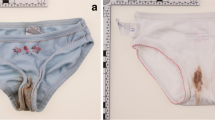Abstract
Bladder exstrophy is a rare malformation characterized by an infra-umbilical abdominal wall defect, incomplete closure of the bladder with mucosa continuous with the abdominal wall, epispadias, and alterations in the pelvic bones and muscles. It is part of the exstrophy–epispadias complex, with cloacal exstrophy on the severe and epispadias on the mild ends of the spectrum. Bladder exstrophy is the most common of these entities and is more common in boys. The goal of this paper is to describe common methods of repair and to provide an imaging review of the postoperative appearances.








































Similar content being viewed by others
References
Kluth D, Hillen M, Lambrecht W (1995) The principles of normal and abnormal hindgut development. J Pediatr Surg 30:1143–1147
Paidas CN, Morreale RF, Holoski KM et al (1999) Septation and differentiation of the embryonic human cloaca. J Pediatr Surg 34:877–884
Penington EC, Hutson JM (2003) The absence of lateral fusion in cloacal partition. J Pediatr Surg 38:1287–1295
Wang C, Wang J, Borer JG et al (2013) Embryonic origin and remodeling of the urinary and digestive outlets. PLoS One 8:e55587
Ambrose SS, O’Brien DP 3rd (1974) Surgical embryology of the exstrophy–epispadias complex. Surg Clin N Am 54:1379–1390
Muecke EC (1964) The role of the cloacal membrane in exstrophy: the first successful experimental study. J Urol 92:659–667
Young RH (2008) Non-neoplastic disorders of the urinary bladder. In: Bostic DG, Cheng L (eds) Urologic surgical pathology. Mosby, China, pp 215–256
Sponseller PD, Bisson LJ, Gearhart JP et al (1995) The anatomy of the pelvis in the exstrophy complex. J Bone Joint Surg Am 77:177–189
Stec AA, Pannu HK, Tadros YE et al (2001) Pelvic floor anatomy in classic bladder exstrophy using 3-dimensional computerized tomography: initial insights. J Urol 166:1444–1449
Gearhart JP, Mathews RI (2011) Exstrophy–epispadias complex. In: Wein AJ, Kavoussi LR, Novick AC et al (eds) Campbell-Walsh urology. W. B. Saunders, Philadelphia, pp 3326–3378
Grady RW, Mitchell ME (1999) Complete primary repair of exstrophy. J Urol 162:1415–1420
Borer JG, Gargollo PC, Hendren WH et al (2005) Early outcome following complete primary repair of bladder exstrophy in the newborn. J Urol 174:1674–1678, discussion 1678–1679
Borer JG, Gargollo PC, Kinnamon DD et al (2005) Bladder growth and development after complete primary repair of bladder exstrophy in the newborn with comparison to staged approach. J Urol 174:1553–1557, discussion 1557–1558
Gargollo P, Hendren WH, Diamond DA et al (2011) Bladder neck reconstruction is often necessary after complete primary repair of exstrophy. J Urol 185:2563–2571
Purves JT, Gearhart JP (2007) Pelvic osteotomy in the modern treatment of the exstrophy–epispadias complex. EAU-EBU Updat Ser 5:188–196
Wild AT, Sponseller PD, Stec AA et al (2011) The role of osteotomy in surgical repair of bladder exstrophy. Semin Pediatr Surg 20:71–78
Lloyd JC, Spano SM, Ross SS et al (2012) How dry is dry? A review of definitions of continence in the contemporary exstrophy/epispadias literature. J Urol 188:1900–1904
Pohl HG (2010) Augmentation cystoplasty in children. In: Graham SD, Keane TE, Glenn JF (eds) Glenn’s urologic surgery. Lippincott Williams & Wilkins, Philadelphia, pp 784–792
Mingin GC, Stock JA, Hanna MK (1999) Gastrocystoplasty: long-term complications in 22 patients. J Urol 162:1122–1125
Rao PK, Iverson AJ, Sabanegh ES (2012) Augmentation cystoplasty technique. http://emedicine.medscape.com/article/443916-technique. Accessed 16 Dec 2013
Cain M (2010) The Mitrofanoff in pediatric urinary tract reconstruction. In: Graham SD, Keane TE, Glenn JF (eds) Glenn’s urologic surgery. Lippincott Williams & Wilkins, Philadelphia, pp 794–799
Simon J (1852) Ectopia vesicae (absence of the anterior walls of the bladder and pubic abdominal parietes): operation for diverting the orifices of the ureters into the rectum, temporary success, subsequent death, autopsy. Lancet 2:568–570
Kiarash M, deKernion JB (2002) Urinary diversions and continent reservoirs. In: Gillenwater JY, Howards SS, Grayhack JT, Duckett JW (eds) Adult and pediatric urology. Lippincott Williams & Wilkins, Philadelphia, pp 1363–1400
Pettersson L, Tranberg L, Abrahamsson K et al (2013) Half century of followup after ureterosigmoidostomy performed in early childhood. J Urol 189:1870–1875
Husmann DA (2006) Surgery insight: advantages and pitfalls of surgical techniques for the correction of bladder exstrophy. Nat Clin Pract Urol 3:95–100
Stec AA, Baradaran N, Gearhart JP (2012) Congenital renal anomalies in patients with classic bladder exstrophy. Urology 79:207–209
McGrath D. Bladder volume calculator. http://users.tpg.com.au/mcgrath_/Calculators/Bladder_Volume_Calculator.html. Accessed 16 Dec 2013
Kaefer M, Zurakowski D, Bauer SB et al (1997) Estimating normal bladder capacity in children. J Urol 158:2261–2264
Halachmi S, Farhat W, Konen O et al (2003) Pelvic floor magnetic resonance imaging after neonatal single stage reconstruction in male patients with classic bladder exstrophy. J Urol 170:1505–1509
Gargollo PC, Borer JG, Retik AB et al (2005) Magnetic resonance imaging of pelvic musculoskeletal and genitourinary anatomy in patients before and after complete primary repair of bladder exstrophy. J Urol 174:1559–1566, discussion 1566
Stec AA, Tekes A, Ertan G et al (2012) Evaluation of pelvic floor muscular redistribution after primary closure of classic bladder exstrophy by 3-dimensional magnetic resonance imaging. J Urol 188:1535–1542
Borer JG, Retik AB (2007) Complications of exstrophy and epispadias surgery. In: Loughlin KR (ed) Complications of urologic surgery and practice: diagnosis, prevention and management. Informa Healthcare, New York, pp 295–300
Higuchi TT, Granberg CF, Fox JA et al (2010) Augmentation cystoplasty and risk of neoplasia: fact, fiction and controversy. J Urol 184:2492–2496
Conflicts of interest
None
Author information
Authors and Affiliations
Corresponding author
Additional information
CME activity
This article has been selected as the CME activity for the current month. Please visit the SPR Web site at www.pedrad.org on the Education page and follow the instructions to complete this CME activity.
Rights and permissions
About this article
Cite this article
Pierre, K., Borer, J., Phelps, A. et al. Bladder exstrophy: current management and postoperative imaging. Pediatr Radiol 44, 768–786 (2014). https://doi.org/10.1007/s00247-014-2892-5
Received:
Revised:
Accepted:
Published:
Issue Date:
DOI: https://doi.org/10.1007/s00247-014-2892-5




